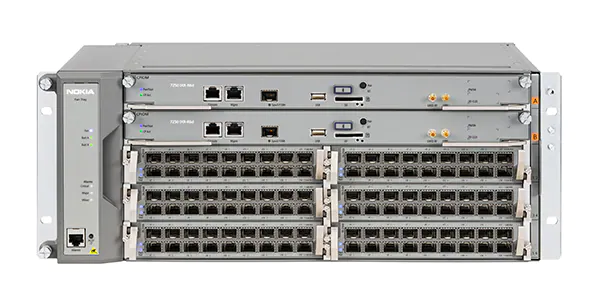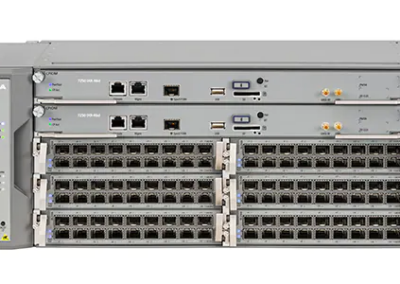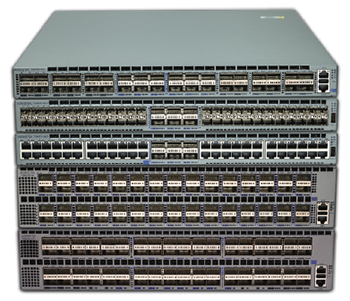BGP
BGP and Juniper fight for king status. If you’re operating an internet-facing network, you’re likely familiar with BGP, the protocol designed by engineers on the back of three ketchup-stained paper napkins, and spoken (almost entirely unchanged) between internet routers since 1994. BGP’s simplicity and flexibility are both its strength and weakness. BGP enables routing to be implemented broadly across the internet, but small configuration errors (such as route leaks or other erroneous advertisements) between networks can potentially cause disastrous routing accidents.
The routing table exchanged via BGP has grown significantly since 1994, and along the way has pushed the limits of each generation of routing hardware. Scaling problems abounded as various hardware vendors hit arbitrary limits with the IPv4 routing table growing over the years. Cisco’s SUP720 maxed out at 256k prefixes, while Brocade’s MLX had similar issues around 600k and 768k. The only solution that has consistently won out: upgrade to a bigger box.
The Rise and Dominance of Juniper MX
Piggybacking on the success of its M series, Juniper addressed the scalability issues of other vendors’ routing platforms, and launched a new MX series in 2006, which featured the newly designed in-house chipset known as Trio. Trio helped firmly establish Juniper’s dominance in the world of core internet routing, with scalability and throughput far outpacing other vendors at the time. The Trio’s unique architecture allowed Juniper more flexibility in table scaling, propelling Juniper into a top contender hardware provider for ISPs and content networks requiring the MX router to sit comfortably at the peering edge, subscriber edge, and core.
Trio’s architecture enables Juniper to offer one of the most feature rich packet processing platforms in the industry, and combined with Junos, this offers all the features that carrier networks (and smaller networks) require. You can perform complex QoS, traffic policing and rate limiting, routing, filtering, switching, packet manipulation, subscriber management, and simultaneously implement complex routing policy all in a deterministic way and at line rate all in one platform (and often all in the same router). The latest generation Trio 6 supports up to a whopping 9.6Tbps of throughput per line card when installed in a Juniper MX10008.
When first brought to market, one of the main differences between Juniper and other vendors was the approach to routing engines and the RIB/FIB with the separation of forwarding and control planes. This allowed Juniper to leapfrog other vendors and introduce new routing engines to increase routing table capacity. Newer generation fabrics (SCB-XX) and line cards could further extend RIB/FIB capacity through the useful life of the router. This flexibility has allowed the MX to scale smoothly through the years with modular growth costs and reduced downtime during upgrade cycles.
Of course, this feature-richness and scalability come with a serious price tag. In certain use cases the cost can easily be justified (e.g., a service provider edge role). Some applications may not have clear cut business cases where architecture is designed to be as simple and cost effective as possible, not requiring the full feature set of the Trio and Juniper MX.
Power Expense
|
DPC-Based SCB RE-S-2000 ~2005 |
MPC4-Based SCBE2 RE-S-1800-X4 ~2014 |
MPC10-Based SCBE3 RE-S-X6 ~2022 |
|
| Throughput | 120-160Gbps/slot | 340-480Gbps/slot | 1-1.5Tbps/slot |
| Memory | 4GB | 16GB or 32GB | 128GB |
| Routes (RIB) | 1-2 million | 8-16 million | 32+ million |
| Routes (FIB) | 1 million | 4 million | 8-16+ million |
Maximum RIB/FIB are completely configuration dependent, numbers are approximate and only for demonstrating scale.
Alternatives to the MX
In architectures that do not require the feature set of the Trio/MX, or where the commercial business case does not support it, there are suitable alternatives from Juniper and other OEMs.
For example, in a basic provider edge role, the Juniper PTX could be suitable. The PTX was originally launched as a high-throughput packet transport switch (sitting in the core performing only LSR-type functions), but over time has found a home in the DCI (data center interconnect) market. Along with this shift in positioning, the PTX gained a more capable in-house developed chipset known as Express.
Couple that with a boost from newer releases of Junos, plus a more capable routing feature set, and you have something akin to MX Lite. If you do not require the subscriber management or policing and QoS features of the MX, yet do require a capable BGP speaker with large table capacity and high throughput, the PTX is a viable option. The PTX is suitable in peering edge and core routing/switching roles. The latest generation Express 5 is capable of up to 28.8Tbps of throughput per slot – compared with the MX and its current limit of 1.5Tbps per slot, you can see the clear trade off between feature capability and port density/throughput.
Alternatively, in the leaf and spine roles of DCI networking, Arista is worthy of mention. Known for high density and low power consumption boxes featuring merchant silicon, Arista added their own software expertise alongside chipsets from Broadcom to enable similar routing scalability as the Juniper MX and PTX. Arista’s lower price point and feature set aimed at the peering edge and core routing/switching layers, have positioned the company for growth in this market. Currently Arista is gaining traction in the traditional BGP edge role. New generation routers like the DCS-7280CR3MK-32P4S are game changers in terms of port density, throughput, and functionality.
Finally, The Nokia SR series is also a solid contender for an alternative to the MX. The Nokia SR is feature and capability rich on par and sometimes exceeding the MX. Nokia’s latest generation of FP5 ASICs also provide for significantly higher throughput than the MX per slot. Depending on the exact configuration, the FP5 enables throughput of 4.8Tbps per slot and a roadmap of up to 18Tbps per slot in future, offering a path to 800GE for those networks with extremely high capacity requirements today.
Conclusion
So BGP and Juniper fight for king status – but who wins the crown? The Juniper MX remains a leader in the routing field, and until only recently the MX was the go-to option for BGP intensive deployments.The BGP playing field has widened with Juniper’s PTX, Arista’s 7280s, and Nokia’s 7250 IXR, which are all excellent options to consider based on your budget, network architecture, scale and production goals.
We Can Help You
To dive further into any of the above mentioned OEM routing options, and gain a better understanding of which box best fits your current and future network needs, please reach out to connect with your team at nesevo.
US & Canada: sales-us@nesevo.com
EMEA & APAC: sales@nesevo.com
You want to talk to us about? Click here for more contact details.
Article: BGP and Juniper fight for king status








